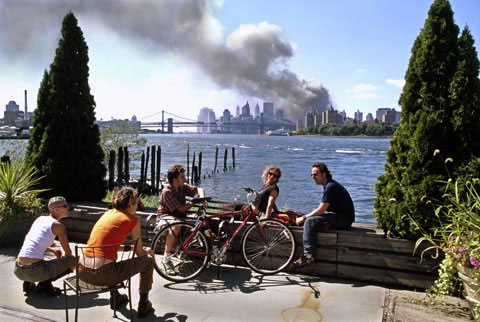‘’ The
picture, I felt, was ambiguous and confusing: Publishing it might distort the
reality as we had felt it on that historic day. I had seen and read about the
outpouring of compassion of New Yorkers toward the stricken families, the acts
of heroism by firefighters, police, and anonymous helpers. This shot didn’t
“feel right” at this moment and I put it in the “B” box of rejected images.’’ –
Thomas Hoeper
This
picture also had some different sides, other than we can see. Two people of
this picture responded to this picture because they said that it is not true
what people are saying and it is not correct and if Hoeper would just come
closer to them and talk to them, he would see completely different side of
these persons.
The
man on the far right of the photo, emailed ‘Slate’ telling more about what is
happening in that picture. He said that it is not true that they didn’t care in
fact they were in state of shock and unbelief. He also said that they weren’t
just relaxing, but they were talking about what is happening. Also he stated
that Hoeper took this picture without their permission and he didn’t know what
they were taking about and he definitely didn’t what they were feeling in that
moment. At the end of his email he said that ‘A more honest conclusion might
start by acknowledging just how easily a photograph can be manipulated,
especially in the advancement of one's own biases or in the service of one's
own career.’ This is true. It is very easy to manipulate with photography and
it is easy to tell what you can see in the photo, but not always you can tell
what people are feeling.
Also woman
second from the right in the photo responded them with an email. In her email
you can see that she was not happy about this picture and she did not like that
the picture was taken without their permission. She also stated that she is
photographer as well but that day she didn’t touch her camera (unlike Hoeper)
because there might be something she could do to help someone instead of taking
her camera and taking pictures of people without their permission. Same as the
man on the far right of the photo said, this picture didn’t show her true
feelings and in fact, her mother worked in World Trade Center and she said that
there was no way that she would not be affected by this event.
[Source
for both responses: http://www.slate.com/articles/news_and_politics/culturebox/2006/09/its_me_in_that_911_photo.html Date: 27/09/2012]
Thomas
Hoeper himself also did response to this photo. In this response he talks about
how he tried to get closer to twin towers to get close up picture of the event.
He was scared but still, he followed his photographer instincts and tried to
get as close as possible. After he found out that subway was closed he decided
to take car to get closer. After a while he decided to go next to river to take
this photo and he found these five young adults sitting next by river and he
saw the colours of flowers, sun shining up on them and this horrible cloud of
smoke in background. He quickly took his camera and took some pictures. He
didn’t know what they were taking about or what they were feeling. After he got
back to his job, he saw a lot of different pictures of this event and they
decided to publish a book about this event and when he was looking through his
pictures and other his college pictures, he decided that it doesn’t ‘feel
right’ and he put the picture in B box where he puts all rejected pictures.
After
4 years he was looking through his B box and was looking at all the pictures
that were there and there were some 50 years old pictures as well. He looked
through them and this picture of 9/11 took his attention because of the colours
and everything else in this picture. He started to think about his emotions
that he had that day.
The
picture ended up on a wall of my retrospective exhibition in his hometown and
many people who walked passed that picture, asked a lot of questions about it.
Everyone seemed really interested in this picture. This picture ended up in 15
newspapers in Germany and in some other newspapers as well. At the end this
picture was on ‘Slate’ as well and it hot really popular really quickly.
[Source
for Hoepers response http://www.slate.com/articles/arts/culturebox/2006/09/i_took_that_911_photo.html Date: 27/09/2012]
